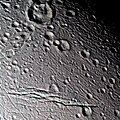Файл:EN004 Painting on the walls.jpg

Розмір при попередньому перегляді: 600 × 600 пікселів. Інші роздільності: 240 × 240 пікселів | 480 × 480 пікселів | 1000 × 1000 пікселів.
Повна роздільність (1000 × 1000 пікселів, розмір файлу: 442 КБ, MIME-тип: image/jpeg)
Історія файлу
Клацніть на дату/час, щоб переглянути, як тоді виглядав файл.
| Дата/час | Мініатюра | Розмір об'єкта | Користувач | Коментар | |
|---|---|---|---|---|---|
| поточний | 01:52, 12 січня 2012 |  | 1000 × 1000 (442 КБ) | OgreBot | (BOT): Uploading old version of file from en.wikipedia; originally uploaded on 2005-06-03 01:20:58 by Volcanopele |
| 16:37, 9 серпня 2005 |  | 600 × 600 (120 КБ) | Changcho~commonswiki | Image of Enceladus' surface taken by Cassini (NASA/ESA) on 9 March, 2005. Image shows tectonic features and crater degradation styles. {{PD}} |
Використання файлу
Така сторінка використовує цей файл:
Глобальне використання файлу
Цей файл використовують такі інші вікі:
- Використання в als.wikipedia.org
- Використання в ba.wikipedia.org
- Використання в ca.wikipedia.org
- Використання в ca.wikinews.org
- Використання в el.wikipedia.org
- Використання в es.wikinews.org
- Використання в fr.wikipedia.org
- Використання в gl.wikipedia.org
- Використання в hu.wikipedia.org
- Використання в it.wikipedia.org
- Використання в pl.wikipedia.org
- Використання в ru.wikipedia.org
- Використання в sk.wikipedia.org
- Використання в sv.wikipedia.org
- Використання в vi.wikipedia.org
- Використання в zh.wikipedia.org


